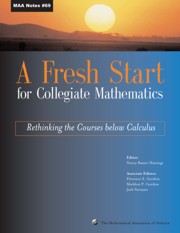Book contents
- Frontmatter
- Preface
- Contents
- Introduction
- Background
- Theme 1 New Visions for Introductory Collegiate Mathematics
- 7 Refocusing Precalculus: Challenges and Questions
- 8 Preparing Students for Calculus in the Twenty-First Century
- 9 Preparing for Calculus and Preparing for Life
- 10 College Algebra: A Course in Crisis
- 11 Changes in College Algebra
- 12 One Approach to Quantitative Literacy: Understanding our Quantitative World
- Theme 2 The Transition from High School to College
- Theme 3 The Needs of Other Disciplines
- Theme 4 Student Learning and Research
- Theme 5 Implementation
- Theme 6 Influencing the Mathematics Community
- Ideas and Projects that Work: Part 1
- Ideas and Projects that Work: Part 2
10 - College Algebra: A Course in Crisis
from Theme 1 - New Visions for Introductory Collegiate Mathematics
- Frontmatter
- Preface
- Contents
- Introduction
- Background
- Theme 1 New Visions for Introductory Collegiate Mathematics
- 7 Refocusing Precalculus: Challenges and Questions
- 8 Preparing Students for Calculus in the Twenty-First Century
- 9 Preparing for Calculus and Preparing for Life
- 10 College Algebra: A Course in Crisis
- 11 Changes in College Algebra
- 12 One Approach to Quantitative Literacy: Understanding our Quantitative World
- Theme 2 The Transition from High School to College
- Theme 3 The Needs of Other Disciplines
- Theme 4 Student Learning and Research
- Theme 5 Implementation
- Theme 6 Influencing the Mathematics Community
- Ideas and Projects that Work: Part 1
- Ideas and Projects that Work: Part 2
Summary
Introduction
This paper presents a case for transforming traditional college algebra from a failed program attempting to prepare students for calculus to one that enables students to address the needs of society, the workplace, and the quantitative aspects of disciplines. Characteristics of improved college algebra programs are described as well as the symbiotic relationship between a transformed college algebra and quantitative literacy.
Traditional college algebra
Traditional college algebra courses are not working [3]. That was the strong consensus of the participants in the Conference to Improve College Algebra, held at the U. S. Military Academy, February 7–10, 2002. This conclusion was based on the courses' outdated content, high FWD rates, and on the negative impact these courses have on student perceptions of mathematics. The large number of students enrolled in College Algebra creates an urgency to transform these courses into ones that do work.
Number of Students
College algebra has the largest enrollment (approximately 400,000 in fall 2000) of any college creditbearing mathematics course [2]. (Another approximately 100,000 students are enrolled in combined college algebra/trigonometry courses.) This enrollment is approximately equal to the combined enrollment in all mainstream calculus courses, having increased from 73% in 1980. Precalculus has the second largest enrollment, which is about half that of college algebra. Almost all students are required to pass one of these courses, or a higher level mathematics course, as part of college distribution or major requirements.
- Type
- Chapter
- Information
- A Fresh Start for Collegiate MathematicsRethinking the Courses below Calculus, pp. 83 - 89Publisher: Mathematical Association of AmericaPrint publication year: 2006
- 4
- Cited by

